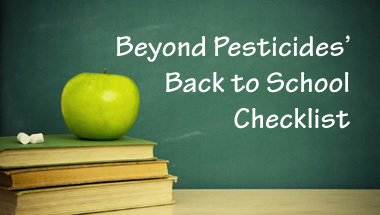23
Aug
Beyond Pesticides’ Back to School Checklist

(Beyond Pesticides, August 23, 2011) It’s that time of the year again for kids to return to the classroom. Unfortunately, children may face unexpected dangers from pesticides, including antibacterial chemicals, used in and around schools. Studies show pesticides can impact a child’s neurological, respiratory, immune, and hormone systems, even at low levels.
Help create a healthier and safer school environment by checking the following items off your Back to School Checklist.
1. Get Triclosan Out of Schools and Supplies.
The antibacterial chemical triclosan is linked to skin irritation, hormone disruption, antibiotic resistance, and more. Avoid products labeled Microban or “with antibacterial protection” as they may contain triclosan (product list). Ask your school to order triclosan-free soap and school supplies. See Back to School flyer.
Take Action: Bath & Body Works has marketed an entire line of triclosan-containing body care products to teenagers. Tell Bath & Body Works’ CEO: “Stop using toxic triclosan in your products.”
2. Improve Your School’s IPM Program.
Children face unique hazards from pesticide exposure because of their small size and developing organ systems. A strong integrated pest management (IPM) program is one of the best ways to minimize or eliminate children’s exposure to pesticides. See how your state’s School IPM rates.
Take Action: Improve your local school’s pest management policy, both indoors and on school grounds and playing fields. For details, see our School Organizing guide.
3. Be Wary of Bed Bugs.
Pesticides used for bed bugs are linked to cancer, hormone disruption, asthma, neurotoxicity, and more. Plus, they are generally ineffective due to resistance. Fortunately, bed bugs do not transmit disease and can be controlled without toxic pesticides.
Take Action: Bed bug infestation is not limited to bedrooms and hotels, so be sure to check backpacks, clothing and school supplies (like binders, books) for bed bugs regularly. For detailed information on prevention and control, download our Bed Bug factsheet.
4. Look Out for Lice.
Head lice are common, but don’t go reaching for toxic lice shampoos! Products containing lindane and permethrin have been linked to cancer, neurological damage and more.
Take Action: Successful treatment relies on an integrated approach that includes monitoring, prevention, physical removal and heat. Learn more in our Head Lice factsheet.
5. Eat (and Grow) Organic Food.
Organic food is healthier for kids as it reduces pesticide exposure, and better for farmworkers and the environment. School gardens teach children where food comes from and establishes healthy relationships with food and the natural world.
Take Action: Ask your school to adopt an organic lunch program, starting with organic produce, milk or juice. Try growing food in an organic school garden. For more information, see, “School Lunches Go Organic” and “The Organic School Garden” (or “Grow Your Own Organic Food” for technical advice).










